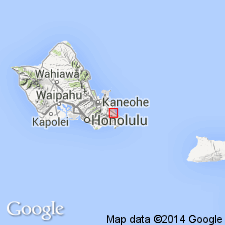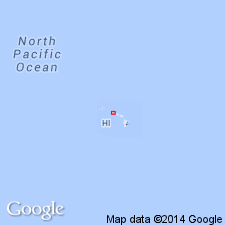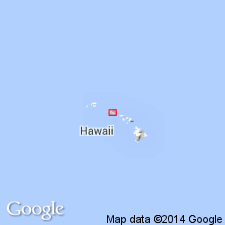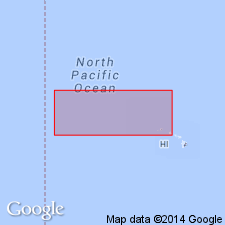
- Usage in publication:
-
- Kaena Formation
- Modifications:
-
- Named
- Dominant lithology:
-
- Limestone
- AAPG geologic province:
-
- Oahu
Summary:
Named after Kaena Point. Type locality of Kaena 95-ft stand of sea [21 deg 34' 40" N, 158 deg 16' 59" W, Kaena 7.5' quad] (Stearns 1935 p. 1936). Consists of "massive transgressive reef and associated limestone" and overlying regressive beachrock conglomerate. Ranges from 70 to 129 ft in thickness. Contains coral, coralline algae, shells, and other reef-building organisms. Unconformably underlies in places Bellows Field Formation (new). Unconformably overlies Kahuku Point Formation (new). Lower unit correlates with Transgression II of Yarmouth interglacial time.
Source: GNU records (USGS DDS-6; Menlo GNULEX).

- Usage in publication:
-
- Kaena limestone
- Modifications:
-
- Redescribed
- AAPG geologic province:
-
- Oahu
Summary:
Kaena Formation called Kaena Limestone in Table 2. The 2nd interglacial Yarmouth is estimated to have occurred 450,000(?) yr B.P.
Source: GNU records (USGS DDS-6; Menlo GNULEX).

- Usage in publication:
-
- Kaena Formation
- Modifications:
-
- Areal extent
- AAPG geologic province:
-
- Oahu
Summary:
Occurs in PCA, Kaiser Cement Company, and Barbers Point quarries in Lualualei valley, Island of Oahu. Here unconformably overlies thin layer of marl and calcareous sandstone of the PCA 25-ft stand of sea.
Source: GNU records (USGS DDS-6; Menlo GNULEX).

- Usage in publication:
-
- Kaena Limestone*
- Modifications:
-
- Age modified
- AAPG geologic province:
-
- Oahu
Summary:
Kaena Formation of Lum and Stearns (1970) adopted as Kaena Limestone as used by Stearns (1974). Age is Sangamon (Pleistocene).
Source: GNU records (USGS DDS-6; Menlo GNULEX).
For more information, please contact Nancy Stamm, Geologic Names Committee Secretary.
Asterisk (*) indicates published by U.S. Geological Survey authors.
"No current usage" (†) implies that a name has been abandoned or has fallen into disuse. Former usage and, if known, replacement name given in parentheses ( ).
Slash (/) indicates name conflicts with nomenclatural guidelines (CSN, 1933; ACSN, 1961, 1970; NACSN, 1983, 2005, 2021). May be explained within brackets ([ ]).

